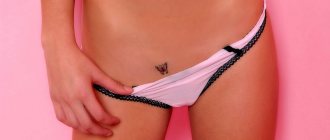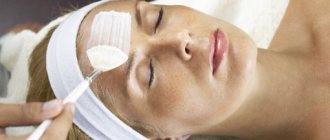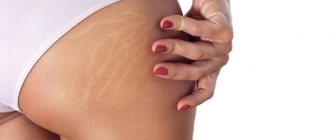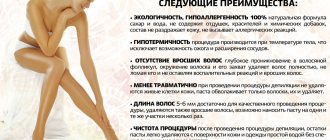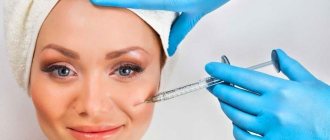Hair removal methods
You can get rid of unnecessary hairs using the following methods:
- mechanical (cutting, pulling);
- chemical (destruction as a result of exposure to chemical mixtures);
- physical (hair dying under the influence of light radiation or electric current).
The methods differ in most parameters and allow you to remove hair for a short or long term, or solve the issue radically. Not all methods are feasible at home, but if the situation requires it, the technique of many of them is not difficult to master on your own.
Growth phase matters
Numerous studies in the field of laser hair removal have shown that the effect of destruction of the hair follicle depends on the stage of hair growth.
Only if there is a pigmented hair shaft associated with the hair follicle, destruction of the follicle is possible. This condition is characteristic of anagen. Hairs located nearby may be in different growth phases and react differently to radiation.
Anagen
Lasts from 1-2 years to 5-7 depending on the anatomical location. Up to 85% of vegetation is in the anagen stage. This is a time of active hair growth and pigmentation. The effect of laser hair removal on hair in the anagen stage leads to maximum results.
Catagen
Degradation, aging of the follicle, occurring over several weeks. It is disconnected from the supplying vessels and nerves and prepares to die.
Hair that is in the catagen stage will also fall out as a result of hair removal, just as it would fall out in the natural course of events. However, the follicle is not destroyed by the impulse, and it soon resumes its growth.
Telogen
This is the resting phase. It contains approximately 15% of the hair. Old hair falls out and new hair begins to grow. At this time, the laser does not affect the follicle at all.
The minimum amount of time you can count on after laser hair removal is 1 - 2 months. Then the hairs that were in the cata and telogen stages are activated.
Depilation methods
The purpose of home depilation is to destroy the part of the hair protruding above the surface of the skin by cutting off the hair shaft or destroying its structure under the influence of chemical compounds.
The methods are considered outdated, but due to the accessibility and painlessness of the procedures, depilation can be easily done at home with a minimum number of equipment and lack of experience. Shaving and applying depilatory products are common methods of depilation at home that do not require preparation or special skills. In the first case, shaving base is applied to the area of skin to be treated and removed using a razor. Electric razors are often used to treat the facial area in men.
The shaving process itself is painless, the result is visible immediately, but lasts for an extremely short period of time. Within 1 – 2 days, and sometimes after a few hours, the hairs grow back. Regular shaving stimulates hair growth and strengthens the hair shaft. Rough stubble is formed, creating the need to repeat the procedure.
The desired smoothness is achieved only by frequent shaving, which causes skin irritation, especially in sensitive areas. Redness and dryness of the dermis become unpleasant companions, coupled with an increased likelihood of improper growth of hair shafts. There is a need to use additional funds.
Other hair removal methods
You can do depilation at home using depilatory cream or foam based on chemical compounds that destroy the hair structure.
The compositions are distributed over a clean and dry skin surface, left for the time specified in the instructions, after which the mass is removed along with the vegetation. Coarse hairs do not respond well to chemical depilation. The simplicity and convenience of the method border on low efficiency and a high risk of local adverse reactions in the form of redness of the skin, irritation, and itching. Before depilation using chemical depilatory agents, you must ensure that there are no allergic reactions.
After chemical depilation, hairs grow back within a couple of days. Treatment cannot be carried out frequently due to the aggressive composition of the products on the skin.
Hair removal methods completely solve the problem more effectively, allow you to get rid of hair on the body and face for a long time and become a godsend for those who are not ready to constantly do hair removal.
Pain relief during the procedure
To reduce pain you can use
- medications (Frost Spray, Lidocaine 10%, Prilocaine, Menovazin);
- cosmetics that contain a mild anesthetic (Emla, Veet, Light dep).
In addition to anesthesia, you can apply a cold compress of ice cubes in a plastic bag to the skin.
Anesthetic cream is applied to clean and dry skin before depilation begins.
Epilation
The epilation process involves removing the entire hair along with the root. Methods of influencing the hair follicle have different mechanisms, and not all hair removal methods are feasible at home. But some techniques are quite suitable for carrying out the procedure yourself.
The maximum result from the procedure is achieved when the hair length is at least 4 - 5 mm.
You can do hair removal at home in the following ways:
- sugaring;
- waxing;
- treatment with an electric epilator;
- photoepilation with portable devices;
- use of home laser devices.
You can also remove entire hairs from small areas of skin using tweezers. Usually, this method is used to shape eyebrows, get rid of nasal hair, or pull out single hairs. It is not advisable to use tweezers on large areas.
Photoepilators and lasers for home use allow you to carry out a salon procedure at home, which ultimately turns out to be much cheaper, especially when treating large areas of skin. Portable devices have power limitations, which prevents obvious harm from being caused if configured incorrectly. The use of devices must be carried out taking into account contraindications in strict accordance with the attached instructions. The devices give good results when processing hairs of dark tones.
At home, people often resort to more traditional methods of sugar and wax hair removal or purchase devices for mechanical hair removal.
Plucking
Most often it is performed on the face to correct eyebrows or remove mustaches above the upper lip. In other cases, it is appropriate to pluck only individual hairs that were accidentally left behind after another depilation method.
Hair is plucked with tweezers, and only one hair is removed per grip. For this reason, depilation in wide areas by plucking is impractical, because it will take too much time, and in some areas it is completely impossible due to the inaccessibility of some places (bikini, especially deep ones, armpits, etc.). The process is not painless, so before pulling out the hair it is better to tighten the skin, and after the procedure soothe it with cream. The slight redness that appears after plucking goes away on its own.
The effect depends on whether the hair is pulled out from the root. If yes, the result will last 5-7 days, which is longer than after shaving, but less than after waxing or sugaring. If not, the broken hair will grow back quickly.
Advantages and disadvantages
Pros:
- tweezers cost a penny;
- no specialist or experience required;
- the effect lasts longer than after shaving;
- no special skin preparation is required;
- no contraindications.
Minuses:
- the effect is several times less than after waxing or sugaring;
- hurt;
- inconvenient for use in some areas;
- not for large areas.
Mechanical epilator
An epilator is a compact device for removing unwanted hair from the roots. The popularity of epilators is due to their high efficiency, ease of use, and affordable price. The principle of operation of the devices is to capture hairs using built-in mechanisms in the form of tweezers, disks or threads and then pull them out.
The epilator is convenient to use for treating large areas of skin. The result lasts for 2 – 3 weeks after treatment. Regular sessions help reduce the number of hairs, thin them and prolong the effect up to 30 – 40 days.
The main disadvantage of using an epilator is that the procedure is painful. Unpleasant sensations are especially pronounced when processing hard and deep-lying hairs. External local anesthetics in the form of a cream, spray or solution help reduce pain. The preparations are applied to the surface of the skin before starting the process, having previously ruled out allergies to the components included in the composition.
After the first sessions, redness and swelling of the skin in the treated area often occur. Subsequent procedures usually take place with less pronounced discomfort, but few people decide to use an epilator in sensitive areas. Sugaring and waxing are considered more universal and gentle methods.
Sugaring
Sugaring is a method of hair removal using a sugar-based paste that has good adhesive properties. The hairs are immersed in the caramel mass and completely removed along with the base. Compared to other methods of mechanical hair removal, sugaring causes less discomfort and virtually eliminates the appearance of ingrown hairs.
Sugaring is considered a safe and relatively painless method of hair removal, applicable at home. The result lasts up to 20–30 days, hairs grow less frequently, and their structure becomes softer. The procedure allows you to get rid of any type of hair, including thin, fluff-like hair.
The pain of the procedure is reduced due to the enveloping properties of caramel. Sugar paste is applied against the direction of hair growth. The composition penetrates the hair follicle, which facilitates subsequent hair removal.
To reduce discomfort from the procedure, you need to prepare the skin in advance. The day before treatment, the skin is cleansed with a scrub. Immediately before the session, the surface is treated with antiseptic agents (a solution of chlorhexidine, salicylic acid or special sprays) and powdered with baby powder or talcum powder.
Compliance with the rules of preparation, sugar hair removal techniques, correct selection or preparation of paste, allows you to do the procedure quickly and provide a good effect.
Tools Overview
Body scrubs
Garnier's Nourishing Beauty Scrub exfoliates with cupuaçu seeds and nourishes with argan, almond, macadamia and rose oils.
Creamy body scrub “Coriander”, Kiehl’s exfoliates due to the action of cylindrical loofah, softens and moisturizes thanks to the content of aloe and chamomile extracts.
Body moisturizing without oils
Moisturizing body milk with bifidocomplex and aloe vera, Garnier strengthens the skin's defenses. Aloe provides intense hydration.
Care that accelerates the restoration of the skin barrier, Cicaplast Gel B5, La Roche-Posay, based on thermal water, hyaluronic acid, panthenol and madecassoside, is designed to restore the skin after aesthetic procedures.
Intensively restorative body milk Nutrix Royal Body, Lancôme, thanks to peptides and hazelnut extract, stimulates the internal forces of the skin and helps restore the hydrolipid mantle.
Ultra-fresh moisturizing body gel Aqua-Gelée, Biotherm effectively moisturizes, is instantly absorbed and is suitable for the most sensitive skin, so it is very appropriate after hair removal.
Sugaring pastes
Sugaring pastes differ in thickness and list of ingredients. The composition should include natural ingredients: sugar, water, lemon juice or citric acid. Sometimes the composition includes plant extracts that soften and soothe the skin.
There are soft, medium and dense pastes. For home hair removal in a cool room, a paste of medium thickness is better, and in a warm room a dense paste is used.
You can make a paste for sugar hair removal at home from regular granulated sugar. To prepare the pasta you will need:
- 10 tablespoons of granulated sugar;
- 30 ml water;
- 30 ml fresh lemon juice.
Sugar and water are placed in a thick-walled pan and heated. After the sugar has dissolved, fresh lemon juice is added. Continue heating the mixture until it turns golden brown and bubbles appear. The sticky caramel is removed from the heat, allowed to cool and immediately used for its intended purpose. Homemade pasta is not intended for storage.
Sugaring technique
Hair removal with sugar paste is done manually (manually) or using a bandage method. The first option requires only a paste of dense or medium consistency without additional equipment. The caramel is heated a little as needed so that the mass can be pressed with your finger.
The paste should be pliable, but not stick to your hands.
With the manual method, the paste is applied to the prepared area of skin with your hands against hair growth. Then, with a quick, confident movement, remove the caramel along with the hairs in the direction of their growth, parallel to the surface. The paste is used more than once. The lump is reapplied until the adhesive properties decrease, after which a new portion is taken.
For bandage sugaring, you will need a medium-density paste and bandages - strips for hair removal made of fabric, paper or polymer materials.
The bandage technique includes the following steps:
- Preparation of the skin.
- Distribute the paste in a movement opposite to the direction of hair growth.
- Cover the caramel layer with a bandage strip, pressing and leveling the surface with your palm, leaving a free edge on top.
- Removing the bandage by the free upper edge with adhered hair with a clear movement along the hair growth, as parallel to the surface as possible while simultaneously pulling the skin in the opposite direction.
- Removing paste residues with warm water.
- Apply a soothing cream or lotion to the treated areas.
Sugaring methods are suitable for treating different areas of the body, including the bikini area, and the face for women and men. Use sugar paste to remove soft and hard hairs. Skin irritations occur rarely and are temporary. The natural ingredients of the paste allow you to use the technique even on sensitive skin.
Sugaring is contraindicated in diabetes mellitus.
No less popular is honey hair removal, which is carried out using the bandage sugaring technique.
Skin preparation
The skin requires some preparation before depilation. For this use:
- Scrub;
- Shower;
- Gel for sensitive skin;
- Talc;
- Special spray with anesthetic;
- Painkillers.
Scrubbing is done two days before the procedure. It is better to use soft cosmetics that do not damage the skin too much. Apply the product with gentle movements against hair growth. You should not use a coffee scrub, as its particles are quite large and can damage the integrity of the skin. A product with apricot or strawberry seeds works well. Scrubbing will remove dead skin particles and prevent ingrown hairs.
Do not use wax on moles, papillomas or lesions as they may break off during the waxing procedure
Before waxing begins, it is recommended to apply an anesthetic spray to the area that will be worked on. This will freeze the skin a little and reduce pain. You can use any other pain reliever. Some artists use talc and powder to reduce the possibility of irritation and burns from hot wax.
Use a gentle soap to clean areas that need to be waxed
Honey hair removal
The honey hair removal method allows you to get rid of unwanted hair, and also nourishes and softens the skin. Honey has an antimicrobial effect, which prevents irritation.
To do hair removal with honey at home, you need to prepare the skin according to the rules of sugaring and prepare a sweet paste, for which you will need:
- 3 tablespoons of liquid (or melted) honey;
- 3 tablespoons sugar;
- 30 ml lemon juice.
The ingredients must be mixed, placed in a water bath and, with constant stirring, brought until the mixture thickens.
As the honey base cools, they begin the procedure, which is carried out by analogy with the bandage method of sugaring. The paste is applied against hair growth, covered with a bandage strip, and removed with a sharp movement in the direction of hair growth. The remaining honey mass is removed with warm water.
Popular questions
Girls and women who are trying a new method of depilation for the first time ask the same questions:
- Why does hair grow ingrown after depilation? Hair grows only in cases where a woman neglects the basic rules of skin care before and after the procedure. Be sure to scrub the skin before depilation and lubricate it with an emollient cream or oil after. When the skin is soft, hair grows easily and does not cause problems.
- How to get rid of ingrown hairs after depilation? Regularly care for your body skin, exfoliate and use nourishing lotion or milk.
- How to remove irritation after depilation? Apply moisturizer to your skin regularly. Irritation is relieved by Panthenol spray or ointment.
- Does waxing hurt? Any depilation is painful, especially in areas where the skin is sensitive. Therefore, before the procedure, it is recommended to lubricate the skin with anesthetic cream or ointment.
- Is it possible to do hair removal during menstruation? It is undesirable, since during menstruation and a few days before it begins, skin sensitivity increases.
- Is it possible to do hair removal during pregnancy? There are no contraindications to depilation - except for chemical ones - for pregnant and lactating women, but before doing it, you should get the approval of your doctor.
- Is it possible to do hair removal after solarium? A week before the procedure and for a week after, you should avoid visiting the solarium and long-term exposure to the sun, otherwise pigment spots may appear on the skin. Before going outside, use cream with an SPF filter.
- What should you not do after waxing? For several days after the procedure, doctors advise avoiding visiting the gym and any intense physical activity, avoid visiting the bathhouse and swimming pool, and do not sunbathe.
- How to remove pigmentation after depilation? Mix hydrogen peroxide (3%) with a couple of sachets of bodyaga to make a paste and apply the mixture in the area where age spots appear. Leave for 30 minutes. At this time, a slight burning sensation may be felt, but if the discomfort is very strong, the mask should be washed off. It is enough to repeat the procedure once a week until the spots lighten. The result is usually visible after 5-6 procedures. In the salon, age spots are treated with laser resurfacing or diamond peeling.
Waxing
Waxing is a method of removing hair from the root using wax. Resinous substances and paraffin are also added to cosmetic waxes for hair removal. The result lasts for up to 30 days. The skin becomes smooth and at the same time renewed due to the removal of keratinized epidermal cells along with wax and hairs.
The procedure is carried out using the following methods:
- hot wax;
- soft (warm) wax;
- cold wax.
Wax for hair removal is purchased ready-made; less often, it is prepared independently. It is better to remove hair with a hard consistency using wax of a hard consistency. Melt the composition in a water bath or in a microwave oven, but it is more convenient to use a wax melter. For the procedure you will also need a spatula and bandage strips.
Preliminary preparation consists of scrubbing the skin a day or two before waxing. Using a scrub to cleanse the skin will reduce the likelihood of ingrown hairs. Before the session, take a shower, treat the areas to be epilated with an antiseptic, and dust with powder.
In case of increased sensitivity, severe pain can be reduced with the help of local anesthetics, as well as the use of anesthetic gels, which you simply need to apply to the treated area before the session. The procedure will become most painless after taking analgesics in the absence of contraindications.
Epilation with hot wax
The hot method is best used to remove coarse hair. More often, the procedure is carried out in a salon, but it can also be done at home, taking precautions when handling hot ingredients. The main disadvantage of hot waxing is the high likelihood of skin burns. Using a wax melter with a built-in temperature sensor helps to avoid wax overheating.
The wax is heated to a temperature of 45 - 50 degrees according to the instructions in the instructions for the composition. When using a microwave oven or water bath, heating takes 2–3 minutes. The consistency of the wax should be viscous and viscous.
The heated wax is distributed with a spatula onto the prepared area of skin according to the hair growth, and covered with a bandage strip on top. After 30–60 seconds, remove the bandage with a sharp, confident movement in the direction against hair growth.
Re-treatment of the area is possible no earlier than after 3 days to avoid skin damage. The single remaining hairs are removed with tweezers.
Remaining wax is removed with a swab dipped in olive or sunflower oil.
Hair removal with warm wax
Using warm wax is safer than hot wax, but the procedure gives poor results when treating coarse hair. The wax mass is heated in an accessible way for the time specified in the instructions (usually less than 1 minute in the microwave) and applied with a spatula according to hair growth. Then cover with a bandage and tear off in the direction of hair growth.
Waxing at home becomes simple and convenient when using wax cartridges. The cartridge is heated in a wax melter and, using the built-in roller, warm wax is applied to the surface of the skin. A bandage is applied to a thin wax layer and the waxing method is followed.
Cold wax epilation
The cold method of waxing involves the use of wax strips, which are a bandage base with a wax layer applied. They produce kits for treating not only arms and legs, but also for hair removal of sensitive areas - armpits and face. Cold epilation is more painless than hot and warm wax.
Wax strips should be held in your palms, warming them with their own warmth. Then the protective shell is removed from the wax layer and the strip is applied to the surface of the skin, leveling and pressing with your hands. The movements are directed according to hair growth, and the bandage is removed in the opposite direction. If necessary, the procedure can be repeated and the bandage can be used more than once.
Home hair removal requires patience and consistency, but the results are worth it. A competent approach will allow you to master the appropriate way to combat unwanted vegetation and achieve good results even in domestic conditions.
Reviews
I can’t shave and the irritation becomes so severe that over time it simply turns into ulcers.
So my only option is to pull my hair. I used to do this with wax strips, but then I bought myself an epilator and for the past 3 years I’ve been epilating my legs and armpits this way only. But I go to the salon to get my bikini done with hot wax, which is now a plasticizing wax, and I liked it much better - it’s less painful, especially since I’m doing a deep bikini. Roksanta https://forum.cosmetic.ua/topic185859.html
I use an epilator everywhere, but in the bikini area I only use depilatory creams, because it doesn’t hurt and because they remove hair deeper than just a razor, and there’s no irritation like with a razor.
But wax is not for me, I can’t stand that much pain. Malva https://forum.cosmetic.ua/topic185859.html
When I didn’t have children and had a lot of free time, I sometimes allowed myself to spend 2 hours on depilation using tweezers.
This is a fairly painless method, but only for legs and a shallow bikini (by the way, you can make a clear pattern “there” with the help of tweezers). Stencils to help... In my life I tried to do sugaring on my own, but this wonderful mixture did not work out for me (((Finally, I was ready to go to the salon for waxing. I did my legs and armpits. The pain was minimal, I really liked the effect/ O-lo -lo https://kosmetista.ru/blog/uhodovaya-kosmetika/2844.html
There is no universal method of depilation that will suit everyone - it probably hasn’t been invented yet. But there are 5-6 quite working methods that you can practice at home, learning how to easily remove hair in any area.

